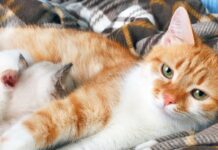Q. We have a 7-year-old male domestic shorthaired cat who lives his life both indoors and out. Given the recent media about the effect of cats on wildlife, my husband and I are conflicted about what to do. We want our boy to be happy, but we don’t want to be contributing to ecological troubles. Do you have any advice?
-Sincerely, Conflicted Parents
A. I completely understand your thoughts on this matter, as recent developments have caused many owners (and cats … believe it or not!) to reconsider their habits and the effects that their lifestyle may have on native populations. The recent study suggesting that domestic cats are contributing to the demise of billions of birds and small mammals points out the fact that the interaction of domestic species with native wildlife is an important issue, one that requires careful thought and action.
Responses to this recent study have ranged from thoughtful consideration to fervent calls for the wholesale banning of cats (perish the thought!). Being a cat, I understand that we cats are natural hunters. When we stalk and catch small prey, we are just acting upon instinct that has evolved over millions of years.
It is ironic that the very behavior that likely prompted our domestication (catching small prey like vermin that would invade vital grain stores) is now the subject of such hot debate. Cats will be cats, and while our predatory behavior may be viewed in a positive light in some circumstances, it can be a source of potential problems in others.
A major issue in this controversy is the size of the feral cat population, and the practices that contribute to this burgeoning trend. Estimates place the size of the U.S. feral cat population at between 60 and 80 million cats. This massive population raises a number of issues ranging from the well-being of feral cats, which can be less than optimal in some cases, to their potential effect on public health and, of course, native species.
Feral cats raise strong voices from both the pro and con camps, but I think that this debate provides an opportunity for us all to come together to address this important issue. Potential solutions to the control of feral cat populations are controversial, but continued research into the development of improved methods of population control, including, for example, a vaccine-based contraceptive, holds promise for the future.
One thing that I think we all agree on is that owners should understand that when they adopt a cat, it is a commitment for the rest of the cat’s life. Too many owners are releasing their cats to become a part of the unowned cat population without thinking about the (numerous) consequences of this practice. Owners should also understand the importance of having their cats spayed and neutered, and they should make every attempt to keep their cats indoors at all times.
I know that you want your kitty to be happy, but it is a fallacy that cats can be happy only when they are allowed outside. Cats who are kept indoors are less likely to be injured by cars and other animals and are generally less likely to contract potentially devastating infectious diseases. Indoor cats also have no effect on native animal populations.
If you feel that you must let your kitty out, an enclosure is a great way to do this, and I have seen some very interesting ones, indeed (see www.paws.org)! If you insist on letting your boy out without enclosures and supervision, it would be best to at least keep him inside during times when native species are most vulnerable (i.e., when fledglings and young mammals are not fully mature). Fitting your cat with a collar with a bell on it may also provide potential prey with advance warning of an approaching kitty and time to escape.
I hope this has provided you with some options and some food for thought. We all want both cats and our native animal friends to thrive in their respective environments, and it is at the interface of these environments that we must focus together on solutions to these issues.
—Sincerely, Elizabeth



